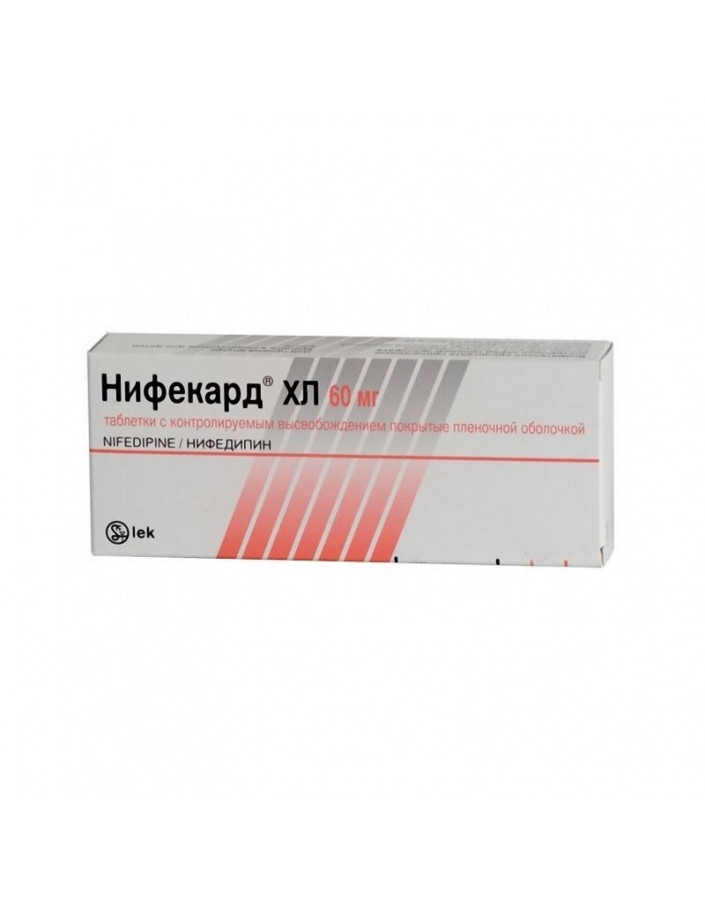




Security policy (edit with Customer reassurance module)

Delivery policy (edit with Customer reassurance module)

Return policy (edit with Customer reassurance module)
Nifedipine is a dihydropyridine derivative. The mechanism of action is the blockade of slow Calcium channels.
Inhibits the transport of calcium ions through the membranes of myocardial cells or vascular smooth muscle cells, without affecting plasma calcium concentrations. The result of this action is the dilatation of arteries and arterioles, a decrease in peripheral vascular resistance and, as a consequence, a decrease in blood pressure. Nifedipine causes dilatation of the main coronary arteries and arterioles in both normal and ischemic areas of the myocardium, and prevents spasm of the coronary arteries.
Nifedipine increases the supply of myocardium with oxygen while reducing the need for oxygen, which allows the use of the drug for the treatment of angina.
Arterial hypertension, ischemic heart disease: stable angina pectoris, vasospastic angina pectoris.
Nifedipine is not prescribed for cardiogenic shock with residual angina pectoris (the risk of myocardial infarction).Caution is prescribed to patients with congestive heart failure, abnormal liver function and diabetes.
For patients with severe obstructive coronary disease, there is a risk of an increase in the frequency, severity of manifestations and duration of strokes after nifedipine. In this case
requires the abolition of the drug.
There are no data on the safety of using nifedipine during pregnancy, so the prescription of nifedipine to pregnant women is indicated only if the possible effect of taking the drug outweighs the possible risk to the fetus.
Nifedipine passes into breast milk, so the drug is not prescribed during lactation.
1 pill of controlled release contains 60mg of nifedipine.
The drug Nifekard XL is prescribed individually. The initial dose of the drug is 30 mg or 60 mg per day once. pills should be taken without chewing, you can not crush or divide (the integrity of the shell provides a controlled release of the active substance). Selection of the dose is carried out gradually, at intervals of 7-14 days.
The maximum daily dose is 90 mg.
With the necessary discontinuation of the drug, the dosage is reduced gradually until complete withdrawal.
From the side of the cardiovascular system: manifestations of excessive vasodilation (asymptomatic decrease in blood pressure, sensation of flushing to the skin of the face, flushing of the skin of the face, feeling of heat), tachycardia,palpitations, arrhythmias, peripheral edema, chest pains; rarely, an excessive decrease in blood pressure, syncope, syncope; in some patients, especially at the beginning of treatment, the occurrence of angina pectoris may occur, which requires discontinuation of the drug. Described isolated cases of myocardial infarction.
From the side of the central nervous system: headache, dizziness, fatigue, weakness, drowsiness; with long-term administration in high doses - paresthesia of the extremities, depression, anxiety, extrapyramidal (parkinsonian) disorders (ataxia, mask-like face, shuffling gait, stiffness of arm and leg movements, tremor of hands and fingers, difficulty swallowing).
On the part of the organ of vision: very rarely - visual impairment (including transient blindness with the maximum concentration of nifedipine in the blood plasma).
On the part of the digestive system: dry mouth, decreased appetite, dyspepsia (nausea, diarrhea or constipation); rarely - gingival hyperplasia (bleeding, soreness, swelling); with long-term use - abnormal liver function (intrahepatic cholestasis, increased activity of hepatic transaminases).
On the part of the blood-forming organs: anemia, asymptomatic agranulocytosis, thrombocytopenia, thrombocytopenic purpura, leukopenia.
On the part of the musculoskeletal system: arthritis; rarely - arthralgia, swelling of the joints, myalgia, cramps of the upper and lower extremities.
On the part of the urinary system: an increase in daily urine output, deterioration of renal function (in patients with renal insufficiency).
On the part of the respiratory system: rarely - difficulty breathing, cough; very rarely - pulmonary edema, bronchospasm.
On the part of the endocrine system: very rarely - gynecomastia (in elderly patients, completely disappearing after discontinuation of the drug), hyperglycemia, galactorrhea, weight gain.
Allergic reactions: rarely - pruritus, rash, exfoliative dermatitis, photodermatitis; very rarely - autoimmune hepatitis.
Simultaneous administration of nifedipine and fentanyl can cause severe hypotension, therefore, it is recommended that nifedipine be removed at least 36 hours before anesthesia (if possible).
When nifedipine is combined with antihypertensive drugs, nitrates and tricyclic antidepressants, the hypotensive effect is enhanced.
With simultaneous appointment with beta-blockers, along with increased hypotensive action, heart failure may develop in some cases.
Combinations of nifedipine with cardiac glycosides with theophylline are usually well tolerated by patients; in very rare cases, there may be an increase in the level of Digoxin and theophylline in the blood plasma.
The combined use of nifedipine and cimetidine (to a lesser extent, ranitidine) can lead to an increase in the level of nifedipine in the blood plasma.
In individual cases, the combination of nifedipine and quinidine, when taken orally, decreases the concentration of quinidine in the blood plasma.
An overdose of nifedipine causes peripheral vasodilation with severe and possibly prolonged systemic hypotension.
Treatment of overdose is to remove the drug from the body and carefully monitor vital functions, heart activity, lungs and the excretory system. The clearance of nifedipine is increased in patients with liver failure. Due to the high degree of binding to plasma proteins, hemodialysis is not effective.
Store at a temperature not higher than 25oWITH.
Conditions of sale from pharmacies Prescription of the doctor